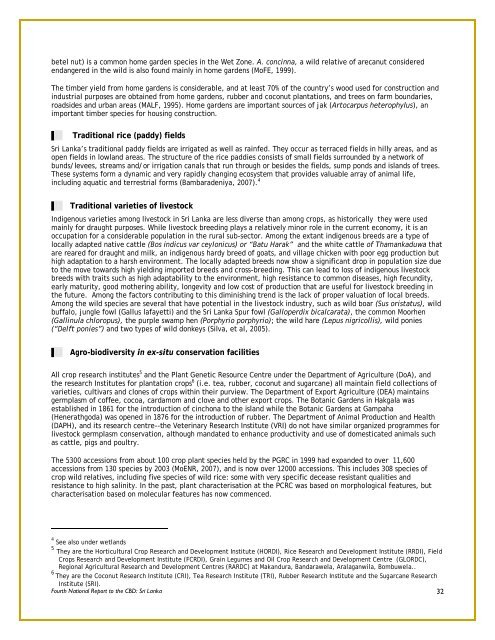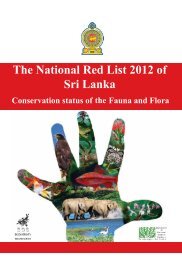English - Convention on Biological Diversity
English - Convention on Biological Diversity
English - Convention on Biological Diversity
Create successful ePaper yourself
Turn your PDF publications into a flip-book with our unique Google optimized e-Paper software.
etel nut) is a comm<strong>on</strong> home garden species in the Wet Z<strong>on</strong>e. A. c<strong>on</strong>cinna, a wild relative of arecanut c<strong>on</strong>sideredendangered in the wild is also found mainly in home gardens (MoFE, 1999).The timber yield from home gardens is c<strong>on</strong>siderable, and at least 70% of the country’s wood used for c<strong>on</strong>structi<strong>on</strong> andindustrial purposes are obtained from home gardens, rubber and coc<strong>on</strong>ut plantati<strong>on</strong>s, and trees <strong>on</strong> farm boundaries,roadsides and urban areas (MALF, 1995). Home gardens are important sources of jak (Artocarpus heterophylus), animportant timber species for housing c<strong>on</strong>structi<strong>on</strong>..11 Traditi<strong>on</strong>al rice (paddy) fieldsSri Lanka’s traditi<strong>on</strong>al paddy fields are irrigated as well as rainfed. They occur as terraced fields in hilly areas, and asopen fields in lowland areas. The structure of the rice paddies c<strong>on</strong>sists of small fields surrounded by a network ofbunds/levees, streams and/or irrigati<strong>on</strong> canals that run through or besides the fields, sump p<strong>on</strong>ds and islands of trees.These systems form a dynamic and very rapidly changing ecosystem that provides valuable array of animal life,including aquatic and terrestrial forms (Bambaradeniya, 2007). 4.11 Traditi<strong>on</strong>al varieties of livestockIndigenous varieties am<strong>on</strong>g livestock in Sri Lanka are less diverse than am<strong>on</strong>g crops, as historically they were usedmainly for draught purposes. While livestock breeding plays a relatively minor role in the current ec<strong>on</strong>omy, it is anoccupati<strong>on</strong> for a c<strong>on</strong>siderable populati<strong>on</strong> in the rural sub-sector. Am<strong>on</strong>g the extant indigenous breeds are a type oflocally adapted native cattle (Bos indicus var ceyl<strong>on</strong>icus) or “Batu Harak” and the white cattle of Thamankaduwa thatare reared for draught and milk, an indigenous hardy breed of goats, and village chicken with poor egg producti<strong>on</strong> buthigh adaptati<strong>on</strong> to a harsh envir<strong>on</strong>ment. The locally adapted breeds now show a significant drop in populati<strong>on</strong> size dueto the move towards high yielding imported breeds and cross-breeding. This can lead to loss of indigenous livestockbreeds with traits such as high adaptability to the envir<strong>on</strong>ment, high resistance to comm<strong>on</strong> diseases, high fecundity,early maturity, good mothering ability, l<strong>on</strong>gevity and low cost of producti<strong>on</strong> that are useful for livestock breeding inthe future. Am<strong>on</strong>g the factors c<strong>on</strong>tributing to this diminishing trend is the lack of proper valuati<strong>on</strong> of local breeds.Am<strong>on</strong>g the wild species are several that have potential in the livestock industry, such as wild boar (Sus oristatus), wildbuffalo, jungle fowl (Gallus lafayetti) and the Sri Lanka Spur fowl (Galloperdix bicalcarata), the comm<strong>on</strong> Moorhen(Gallinula chloropus), the purple swamp hen (Porphyrio porphyrio); the wild hare (Lepus nigricollis), wild p<strong>on</strong>ies(“Delft p<strong>on</strong>ies”) and two types of wild d<strong>on</strong>keys (Silva, et al, 2005)..11 Agro-biodiversity in ex-situ c<strong>on</strong>servati<strong>on</strong> facilitiesAll crop research institutes 5 and the Plant Genetic Resource Centre under the Department of Agriculture (DoA), andthe research Institutes for plantati<strong>on</strong> crops 6 (i.e. tea, rubber, coc<strong>on</strong>ut and sugarcane) all maintain field collecti<strong>on</strong>s ofvarieties, cultivars and cl<strong>on</strong>es of crops within their purview. The Department of Export Agriculture (DEA) maintainsgermplasm of coffee, cocoa, cardamom and clove and other export crops. The Botanic Gardens in Hakgala wasestablished in 1861 for the introducti<strong>on</strong> of cinch<strong>on</strong>a to the island while the Botanic Gardens at Gampaha(Henerathgoda) was opened in 1876 for the introducti<strong>on</strong> of rubber. The Department of Animal Producti<strong>on</strong> and Health(DAPH), and its research centre--the Veterinary Research Institute (VRI) do not have similar organized programmes forlivestock germplasm c<strong>on</strong>servati<strong>on</strong>, although mandated to enhance productivity and use of domesticated animals suchas cattle, pigs and poultry.The 5300 accessi<strong>on</strong>s from about 100 crop plant species held by the PGRC in 1999 had expanded to over 11,600accessi<strong>on</strong>s from 130 species by 2003 (MoENR, 2007), and is now over 12000 accessi<strong>on</strong>s. This includes 308 species ofcrop wild relatives, including five species of wild rice: some with very specific decease resistant qualities andresistance to high salinity. In the past, plant characterisati<strong>on</strong> at the PCRC was based <strong>on</strong> morphological features, butcharacterisati<strong>on</strong> based <strong>on</strong> molecular features has now commenced.4 See also under wetlands5 They are the Horticultural Crop Research and Development Institute (HORDI), Rice Research and Development Institute (RRDI), FieldCrops Research and Development Institute (FCRDI), Grain Legumes and Oil Crop Research and Development Centre (GLORDC),Regi<strong>on</strong>al Agricultural Research and Development Centres (RARDC) at Makandura, Bandarawela, Aralaganwila, Bombuwela..6 They are the Coc<strong>on</strong>ut Research Institute (CRI), Tea Research Institute (TRI), Rubber Research Institute and the Sugarcane ResearchInstitute (SRI).Fourth Nati<strong>on</strong>al Report to the CBD: Sri Lanka 32














